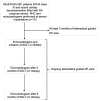Case Series Evaluating the Relationship of SGLT2 Inhibition to Pulmonary Artery Pressure and Non-Invasive Cardiopulmonary Parameters in HFpEF/HFmrEF Patients-A Pilot Study
- PMID: 39943245
- PMCID: PMC11820521
- DOI: 10.3390/s25030605
Case Series Evaluating the Relationship of SGLT2 Inhibition to Pulmonary Artery Pressure and Non-Invasive Cardiopulmonary Parameters in HFpEF/HFmrEF Patients-A Pilot Study
Abstract
The initiation of sodium-glucose cotransporter 2 (SGLT2) inhibitor treatment was shown to reduce pulmonary artery pressure (PAP) in New York Heart Association (NYHA) class III heart failure (HF) patients with an implanted PAP sensor. We aimed to investigate the impact of SGLT2-I initiation on pulmonary vascular resistance (PVR), pulmonary capillary wedge pressure (PCWP), pulmonary arterial capacitance (PAC), and right ventricle (RV) to PA (RV-PA) coupling in a pilot cohort of HF with preserved/mildly reduced ejection fraction (HFpEF/HFmrEF) patients and whether PVR and PCWP can be serially calculated non-invasively using PAP sensor data during follow-up.
Methods: Right heart catheterization parameters (PVR, PCWP, and PAC) were obtained at sensor implantation and echocardiographic assessments (E/E', RV-PA coupling, and RV cardiac output) were made at baseline and every 3 months. SGLT2 inhibition was initiated after 3 months of telemedical care. Three methods for calculating PVR and PCWP were compared using Bland-Altman plots and Spearman's correlation.
Results: In 13 HF patients (mean age 77 ± 4 years), there were no significant changes in PAP, PVR, PCWP, RV-PA coupling, or PAC over 9 months (all p-values > 0.05), including after SGLT2-I initiation. PVR values were closely correlated across the three methods (PVRNew and PVRNew Tedford (r = 0.614, p < 0.001), PVREcho and PVRNew Tedford (r = 0.446, p = 0.006), and PVREcho and PVRNew (r = 0.394, p = 0.016)), but PCWP methods lacked reliable association (PCWPEcho and PCWPNew (r = 0.180, p = 0.332).
Conclusions: No changes in cardiopulmonary hemodynamics were detected after hemodynamic telemonitoring either prior to or following SGLT2-I initiation. Different PVR assessment methods yielded comparable results, whereas PCWP methods were not associated with each other. Further investigations with larger cohorts including repeated right heart catheterization are planned.
Keywords: RV-PA coupling; SGLT2 inhibitors; heart failure; pulmonary artery pressure; pulmonary vascular resistance.
Conflict of interest statement
BA reports having received lecture and/or consulting fees from Abbott, AstraZeneca, Bayer, Boehringer Ingelheim, Bristol Meyers Squibb, Edwards, Novartis, NovoNordisk, Pfizer, Vifor CSL, and ZOLL. EJH reports receiving lecture fees from Bayer and CSL Vifor. SS has received speaker’s/consultancy honoraria from Boehringer Ingelheim GmbH, Astra Zeneca, Novartis (additional research grant), Berlin-Chemie, Menarini, Bristol-Myers-Squibb, and Amgen.
Figures




References
-
- McDonagh T.A., Metra M., Adamo M., Gardner R.S., Baumbach A., Böhm M., Burri H., Butler J., Čelutkienė J., Chioncel O., et al. 2023 Focused Update of the 2021 ESC Guidelines for the diagnosis and treatment of acute and chronic heart failure. Eur. Heart J. 2023;44:3627–3639. doi: 10.1093/eurheartj/ehad195. - DOI - PubMed
-
- Solomon S.D., McMurray J.J., Claggett B., de Boer R.A., DeMets D., Hernandez A.F., Inzucchi S.E., Kosiborod M.N., Lam C.S., Martinez F., et al. Dapagliflozin in Heart Failure with Mildly Reduced or Preserved Ejection Fraction. N. Engl. J. Med. 2022;387:1089–1098. doi: 10.1056/NEJMoa2206286. - DOI - PubMed
-
- Butler J., Filippatos G., Siddiqi T.J., Brueckmann M., Böhm M., Chopra V.K., Ferreira J.P., Januzzi J.L., Kaul S., Piña I.L., et al. Empagliflozin, Health Status, and Quality of Life in Patients with Heart Failure and Preserved Ejection Fraction: The EMPEROR-Preserved Trial. Circulation. 2022;145:184–193. doi: 10.1161/CIRCULATIONAHA.121.057812. - DOI - PMC - PubMed
MeSH terms
Substances
Grants and funding
LinkOut - more resources
Full Text Sources
Medical
Research Materials
Miscellaneous

